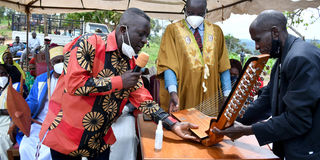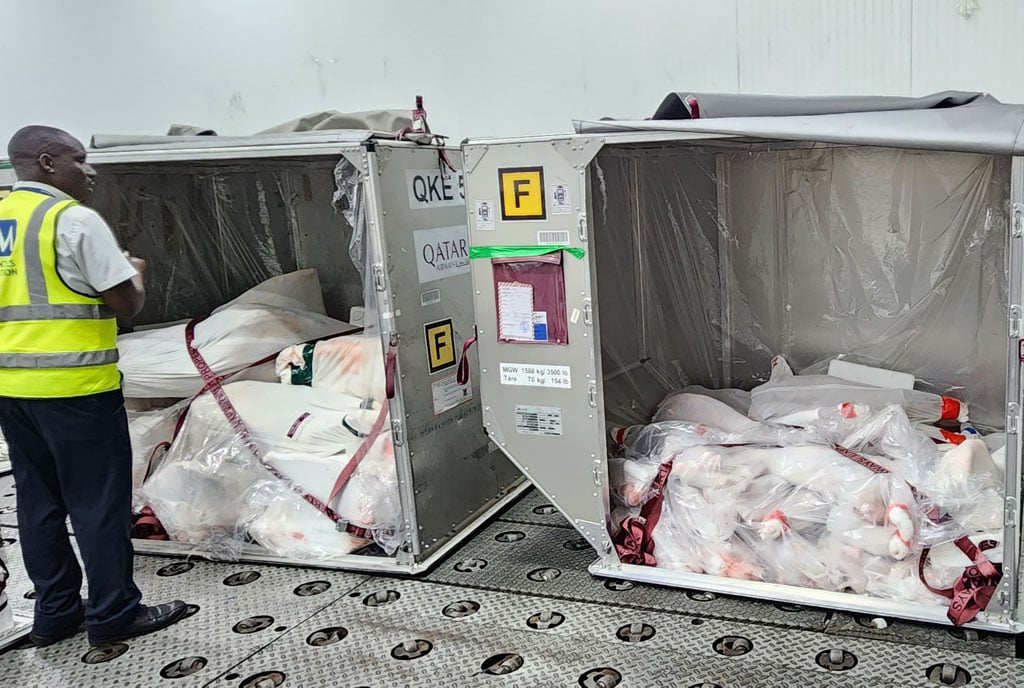Bukenya finds a fortune in production of the bark cloth

Bukenya (right) explains how he uses the bark cloth to beautify the music instrument. PHOTO | EDGAR R. BATTE
What you need to know:
- The United Nations Educational, Scientific and Cultural Organisation (UNESCO) declared bark cloth a ‘Masterpiece of Oral and Intangible Cultural Heritage’ in 2005 and added it to the UNESCO World Heritage list in 2008.
With both hands, he scrapes the bark of the tree as he quickly collects the peelings.
He does so with precision, cautious that his mentor is looking on. As Paul Bukenya Katamira supervises the mentee, he calls on another to find out if the water he is boiling is ready so they can boil the tree bark material.
In an adjacent house shell, another student is beating a stretched-out material with a ridged hammer which, as I learn, from Bukenya is one of the processes in the illustrious process of making bark cloth, a tradition that has run in his family for more than 100 years.
Bukenya’s dream
It is a different day. Between supervising learners, one of whom is his son, Bukenya sits with his mother to proudly and happily narrate to her about the Janzi Award he has won.
The grey-haired seasoned bark cloth maker was recipient of an accolade in the inaugural edition of the awards under the category of ‘Outstanding Craftsman and Weaver’ in the Visual Arts category.
“Paul Bukenya Katamiira’s skilful dedication to the practice of backcloth making and preservation of the Mutuba tree, inherited from his forefathers helped it to make it to the list of the Intangible Cultural Heritage of Humanity (originally proclaimed in 2005) by Unesco,” explains Nuwa Wamala Nyanzi. Nyanzi is a visual arts practitioner and consultant.
He adds that it is therefore gratifying to know that Bukenya’s immense contribution to its sustainable practice and preservation was recently recognised, when he won the Janzi Award.
Indeed, the cordiality when he took the accolade to his village, was enjoyed by everyone at Bukomansiimbi Organic Tree Farmers Association (Botfa), including artist Fred Mutebi whose paintings creatively bear out the use of fabric, and unique textured brown material that is treasured among the Baganda.
During the wedding of the Kabaka of Buganda, Ronald Muwenda Mutebi II in 1999, Mutebi was one of the young graduates decorating the wedding podium, under the leadership of the late Prof Ignatius Sserulyo, the then lecturer at Makerere University school of industrial and fine arts.
What makes him tick
The design of the podium was predominantly of bark cloth design. This created curiosity onto Fred Mutebi’s mind and he promised himself to pursue it further in his artistic life career.
“Bark cloth is the unexplored gold which could fetch more revenue for our country than all the minerals put together. What shall we do when the oil and some of the minerals are exhausted in the future?” argues Mutebi, a member of board of the Uganda National Cultural Centre.
He adds, “As government, we are committed to protecting, preserving our culture and heritage. Bukenya is bark cloth maker, a craft we’ve had for over 800 years. Time came when bark cloth was on the verge of extinction, but UNESCO vied for its protection because it is a unique innovation that’s unique to Uganda and discovered in Buganda.”
The United Nations Educational, Scientific and Cultural Organisation (UNESCO) declared bark cloth a ‘Masterpiece of Oral and Intangible Cultural Heritage’ in 2005 and added it to the UNESCO World Heritage list in 2008.
Given its value, Mutebi selflessly promotes Bukenya’s craft who at 60 years, is one of Uganda’s go-to people on matters regarding bark cloth which is believed to have been promoted by Kabaka Kimera between 1374 and 1404. Bukenya knows bark cloth right from the first principles.
Proud of his work
“I love and I am proud of bark cloth because it has given me fame. I have hosted different people here. I have received local and international media that seek to learn and appreciate bark cloth and its unique making process. My recent win at the Janzi Awards is a big recognition for people who innovate using their hands,” he told locals at a function in Bukomansiimbi.
Bukenya is a pivotal person in many artistic processes. “Among the designers and artists I have met and also appreciate their contribution to my career are Fred Mutebi (Uganda), Leslie Robertson (US), Jose Hendo (UK), Kirsten Scott (UK), Doreen Namatovu (Uganda) Philipp Balimunsi (Uganda)- the curator of UNCC, Hellen Nabukenya and many others,” he says.
“I loved the fact that he got the idea of the bark cloth production from his father, and he still keeps it on going through his children. There was a lot to learn from him more so making art as a business and knowledge for me and for our own children because if it’s what they see every day in life then they will appreciate it and live it and feed from it,” Nabukenya explains, adding that bark cloth is priceless.
Sheila Nakitende has not yet worked with Bukenya but is happy that a documentary is going to be shot for an organisation towards institutional purposes about his work.
The idea for them is to link his practice to Nakitende who is also an artist passionate about experimenting with different materials and fabrics. She says that he is one of the few from the older generation that is sustaining the bark cloth making process not only through engaging in it but passing on the knowledge through teaching the youth in his community.
Her practice on the other hand, is evolving the bark cloth textile through transforming it into different variations of paper and making art from it, when you look at both processes.
Process
There are some similarities such as boiling and beating the fibre with a mallet (ensaamu). However, there’s a difference in the results. “It is from the few people such as Bukenya that we, artists, can still access bark cloth. What makes Bukenya unique is his persistence to the craft and willingness to share the knowledge. He comes from a lineage of bark cloth makers,” Nakitende explains.
Bark cloth making is an intense process. Currently, not many people are patient enough to engage in that kind of work. She adds: “My journey working with bark cloth is a learning experience. Being experimental, I am enjoying the process and the results it is unfolding. I have been doing practical research on the material for the past four years and working towards a solo exhibition.”
Bark cloth is such a uniquely beautiful fabric that international brands, Puma and Mercedes Benz have estimably used it to distinctively enhance the beauty of their merchandise something that has tickled creative and Pan-African minds about the patent of the fabric that’s harvested from the tree bark of the Mutuba tree.
Family affair
Bukenya is one of many irked at learning that a Germany national, who has once visited him, is heard to have patented bark cloth. The Bukomansimbi local has gained an accumulation of family knowledge through the generations which enables him to produce bark cloth of excellent quality.
Like that, he has carried on the family tradition by teaching his sons and many other young men this heritage which ensures continuity. There are some similarities such as boiling and beating the fibre with a mallet (ensaamu). However, there’s a difference in the results.
“It is from the few people such as Bukenya that we, artists, can still access bark cloth. What makes Bukenya unique is his persistence to the craft and willingness to share the knowledge. He comes from a lineage of bark cloth makers,” agrees all the aforementioned artists.
Bark cloth making is an intense process. Currently, not many people are patient enough to engage in that kind of work. Nakitende discovered that before she met Bukenya, her grandfather owned many Mutuba trees and was a bark cloth maker. That gave her a greater appreciation for Bukenya.
She adds: “We both lost our fathers soon after we met, Paul was so kind and invited us to plant a Mutuba tree with him and his family in memory of both our fathers.”
Benefits
Mutebi also cites that besides serving bark cloth value, the Mutuba tree leaves are fodder for animals; from the smallest to the largest, its back and leaves have medicinal values for humans and animals as well as contributing to soil fertility and environment stabilisation.
He observes that the value chain of bark cloth is embedded with all the solutions to the challenges daunting modern man today and the future; locally, regionally, continentally and globally.
Youth need jobs and a conducive environment to live in. Bark cloth value chain is the answer. The Prof Ssengendo’s woven bark cloth, which has not been highlighted enough was one of the breakthroughs that encouraged Fred Mutebi pull extra weight to promoting bark cloth. “If someone had taken it on meaningfully after the passing of Prof Ssengendo, it would fetch a considerable amount of revenue for our country. The missing link is the sustainable supply of the material. Serious investment should be considered. That is why I am encouraging massive Mutuba tree planting and skill the youth in the processing and management of the trees,” says Mutebi.
Mutebi further explains: “A farmer should earn between Shs5,000 and Shs150,000, a harvester should be paid between Shs10,000 and Shs150,000 all depending on the size of the tree and who is controlling the trade.”
Promotion
Bukenya is passionate about promoting bark cloth so much that he is willing to serve as an ambassador of the fabric and the Mutuba tree to protect mother earth if he can get the attention artistes such as Eddy Kenzo got when he bagged the BET Award.
He further explains, “ I continue to harvest good barkcloth because a good Mutuba tree can give you five and more harvests, making it sustainable. There is a possibility that I will pass them on to my children. Government should consider promoting and encouraging the planting of Mutuba tree.”
Bukenya says he has worked with Dr Grace Nambatya of the ministry of health and a specialist in herbal medicine. The two caught the attention of President Museveni in 2017, something that has kept Bukenya’s optimism high that the Mutuba tree will one day be considered as an option to save the environment as it sustainably provides a source of livelihood to youth, and adults alike to solve the challenge of unemployment while showcasing the uniqueness of the natural fabric.



